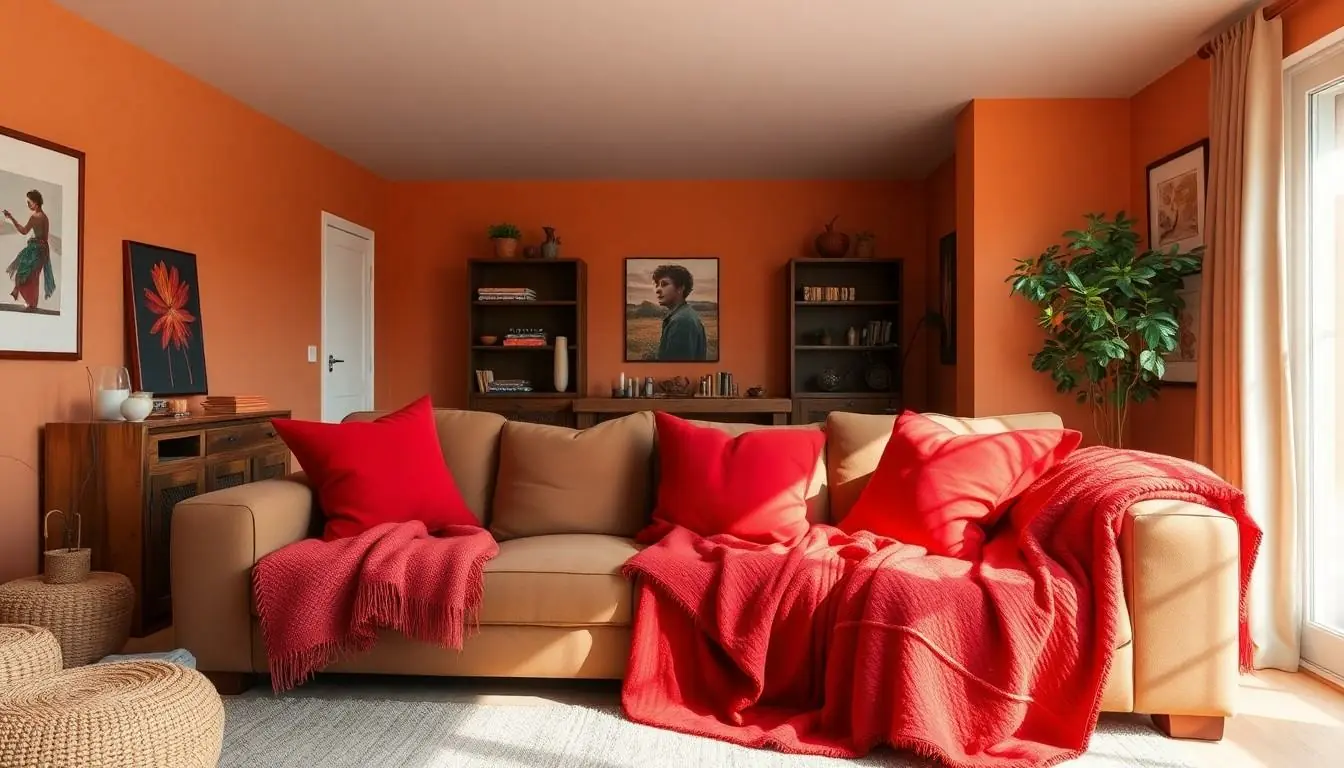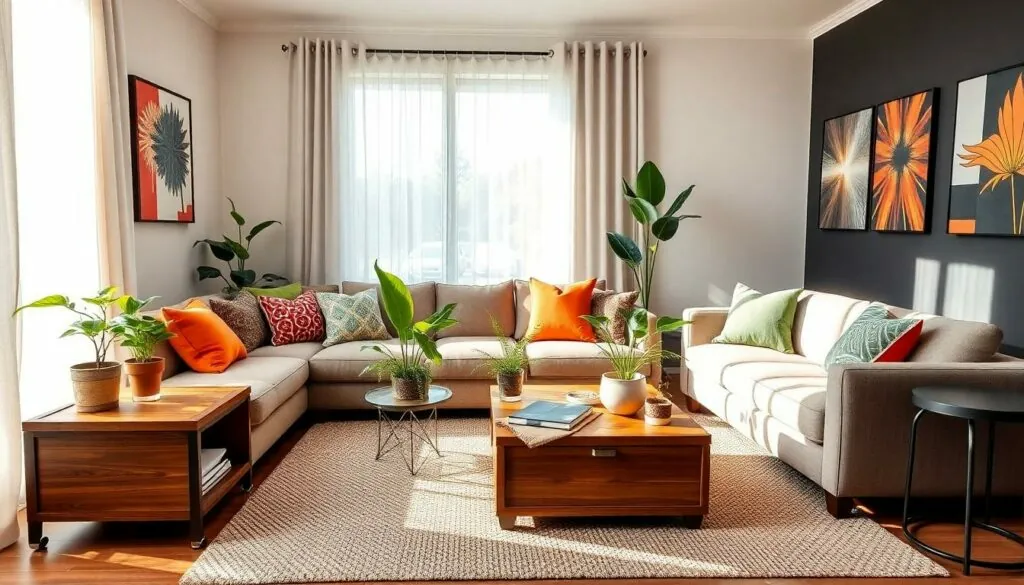Transforming a living room can feel like tackling a giant puzzle—exciting yet daunting. But fear not! With a sprinkle of creativity and a dash of inspiration, that drab space can become the heart of the home. Whether it’s cozy nooks for Netflix marathons or vibrant spaces for entertaining friends, the right ideas can make all the difference.
Table of Contents
ToggleInspiration Living Room Ideas
Creating a captivating living room involves various design elements and styles. Start with color schemes; neutral tones promote tranquility while bold colors energize the space. Adding accent walls further enhances visual interest and sets a distinctive mood.
Incorporate furniture that reflects personal style. Mid-century modern pieces often feature sleek lines and vibrant colors, making them both functional and stylish. Consider sectional sofas; they provide ample seating and foster conversation.
Lighting plays a crucial role in a living room’s ambiance. Layered lighting, including floor lamps, table lamps, and ceiling fixtures, creates depth and highlights key areas. Natural light is equally important; sheer curtains can allow sunlight while maintaining privacy.
Textures enrich the environment. Use a mix of materials such as soft textiles, wooden elements, and metallic accents. Rugs can anchor furniture groups and add warmth underfoot, enhancing comfort.
Accessorizing brings character to the space. Wall art, mirrors, and decorative pillows can express individuality. Plants also contribute to a vibrant atmosphere, improving air quality while adding a touch of nature.
Functional elements should not be overlooked. Coffee tables with storage maximize utility while keeping the area tidy. Shelving units can display books and cherished items, merging style with organization.
Choosing a cohesive theme is essential. Contemporary designs often utilize minimalism, while bohemian aesthetics embrace eclectic combinations. Identify a theme that resonates to create a unified look.
Adapt the layout to suit everyday needs. Arranging seating around a focal point fosters engagement. Consider traffic flow; ensure clear pathways maintain ease of movement.
Color Schemes for a Cozy Atmosphere

Color schemes play a vital role in creating a cozy atmosphere in a living room. Choosing the right palette can transform an ordinary space into a welcoming haven.
Warm Tones
Warm tones such as reds, oranges, and yellows create an inviting environment. These colors stimulate energy and foster interaction among family and friends. Utilizing warm hues on walls paired with complementary decor can enhance comfort. Accents like throw pillows and blankets in these shades can add warmth without overwhelming the space. Consider pairing warm tones with natural wood elements to add depth and texture. Layering these colors throughout the room can maintain visual interest while ensuring a cohesive aesthetic.
Cool Tones
Cool tones like blues, greens, and purples promote relaxation and serenity. These colors can evoke a soothing ambiance, ideal for unwinding after a long day. Light shades of blue or green on walls can make the room feel more spacious. Incorporating cool-toned furniture and accessories provides a perfect balance with warmer accents. Soft lighting enhances the calming effect of cool colors, making them look inviting. This combination encourages a tranquil and peaceful setting, making the living space perfect for quiet evenings or cozy gatherings.
Furniture Selection and Arrangement
Selecting and arranging furniture significantly impacts the overall appeal of a living room. A harmonious setup enhances comfort while reflecting personal style.
Choosing the Right Sofa
Selecting the right sofa serves as a central element in living room design. Sofas come in various shapes such as sectional, loveseat, and traditional styles. Comfort is essential, so opting for high-quality materials ensures durability. Color choice matters; neutral tones blend seamlessly, while bold hues create striking statements. For smaller spaces, consider a sleek loveseat to maximize area without sacrificing seating. Accessories like decorative pillows and throws can add layers of texture and personality.
Arrangement Tips for Open Spaces
Arranging furniture in open spaces presents unique challenges and opportunities. Position seating to create a natural conversation area, focusing on a central point like a coffee table. Utilizing area rugs can define specific zones, making larger rooms feel cozier. Opt for multifunctional furniture, such as ottomans that can serve as both seating and storage. Be mindful of traffic flow; leaving clear pathways ensures easy movement throughout the space. Incorporating varied heights with decorative elements adds visual interest, enhancing the overall aesthetic.
Accessorizing Your Living Room
Accessorizing a living room adds personality and flair. Thoughtful decoration choices elevate the overall aesthetic.
Wall Art and Décor
Choosing wall art significantly impacts the living space’s character. Consider large canvas pieces to create a focal point. Smaller framed prints can add layers of interest around the room. Mirrors serve a dual purpose by enhancing light and giving the illusion of space. Adding personal items like travel photos or handmade crafts fosters a unique atmosphere. Wall shelves provide a great way to showcase decorative objects and plants. Incorporating a mix of textures and colors keeps the decor dynamic and engaging.
Lighting Options for Ambiance
Effective lighting transforms a living room’s mood and functionality. Layering different lighting sources promotes depth and warmth. Table lamps and floor lamps can create cozy spots for reading. Ceiling fixtures, like chandeliers or pendant lights, serve as striking focal points. Dimmable lights allow control over brightness for various activities. Natural light enhances the environment and should be maximized with sheer curtains. Consider accent lighting to highlight artwork or architectural features, adding drama and sophistication.
Incorporating Nature into Your Space
Bringing natural elements into a living room creates a refreshing and serene atmosphere. Nature’s influence adds life and energy to the area.
Plants and Greenery
Incorporating plants enhances indoor air quality and boosts overall wellness. Popular choices include snake plants, pothos, and peace lilies, as they thrive in various light conditions. Grouping plants at different heights showcases their beauty and adds vibrant greenery. Utilizing decorative pots, such as ceramic or woven baskets, complements the design theme. Placing a large floor plant, like a monstera, in a corner draws the eye and creates a focal point. Maintaining a care routine ensures the plants remain healthy and visually appealing.
Natural Materials in Design
Natural materials, such as wood, stone, and rattan, ground the living room and promote a warm ambiance. Using reclaimed wood for furniture pieces or accent walls injects character and sustainability. Stone elements, like a fireplace hearth or a coffee table, introduce texture and a rustic feel. Rattan chairs or baskets add lightness and charm to the arrangement. Choosing neutral or earth-tone textiles, like cotton or linen, enhances the natural aesthetic. These materials create harmony and connection between the indoor space and the outdoors, fostering a peaceful environment.
Transforming a living room into a vibrant and inviting space is an achievable goal with the right inspiration and creativity. By carefully selecting color schemes and furniture styles that reflect personal taste, anyone can enhance the room’s appeal.
Incorporating various textures and lighting options not only adds depth but also sets the mood for relaxation or social gatherings. Accessorizing with unique decor and natural elements brings character and warmth, creating a welcoming environment.
Ultimately, a well-designed living room fosters connection and comfort, making it a cherished space for both everyday activities and special occasions. Embracing these ideas can lead to a stunning transformation that resonates with personal style and functionality.



